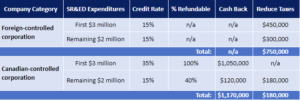SR&ED FAQ: How Does SR&ED Work in Canada?
5 min read
5 min read
As experts in the Canadian Scientific Research and Experimental Development (SR&ED) Tax Incentive Program, we often find companies have a basic understanding and appreciation of the program, but still require clarification on certain aspects. We’ve identified the most common questions companies have with regards to eligibility, application, and review of their SR&ED files.
Simply put, the SR&ED tax credit program enables foreign-controlled and Canadian-controlled companies to earn investment tax credits on qualified expenditures either in the form of a cash refund, a reduction in taxes paid, or both.
Companies qualify if they have performed eligible research and development (R&D) to create a new product or process or improve an existing one.
Here is a short list of expenses that can be compiled when calculating total credits owed to you:
Prior to 2014, capital expenditures, such as new equipment and machinery were eligible for SR&ED credits. Since then, they’ve been eliminated from the program, but may be deducted from business income as a depreciation expense.
To qualify, you need to be doing one of three activities:
Fun fact: Most SR&ED claims fall under the experimental development stream.
Moreover, any work that directly supports the main R&D activities above is also eligible.
Download our guide on using SR&ED to fuel growth
Federally, the credit rate depends on two factors:
Below is a summary of maximum federal credit rates for a fictional company with $5 million in eligible SR&ED expenditures:

Source: Government of Canada
Recall that the above figures only reflect federal rates. To see how provincial rates are added, please contact our funding experts for a free consultation.
If the founding member owns 10% or more of the issued shares of any class of the capital stock, that founder is deemed a “specified employee”.
When claiming SR&ED for specified employees, there are two constraints:
Absolutely not. Cumulatively, however, if project costs (measured in salaries and wages) surpass a certain threshold, your refundable rate may decrease.
For example, certain corporations may earn the tax credit at the enhanced rate of 35% up to a maximum threshold of $3 million in eligible R&D expenses. Anything more than $3 million, the basic rate of 15% applies.
See question four for an example of how SR&ED rates are affected.
An eligible Canadian employee is one that is a Canadian tax resident and who is issued a T4 by the employer.
The determination of residency status generally depends on two factors: significant residential ties to Canada (i.e. a home) or secondary residential ties to Canada (i.e a car or bank accounts).
Immigration status has no real bearing on determining an employee’s eligibility. As long as taxes are being paid in Canada, foreign workers who are in Canada on a visa or who have permanent residency (PR) status are just as eligible as Canadian citizens.
None. While this may have an impact on branding, intellectual property, and international trade, this has no bearing on your eligibility to the SR&ED program, nor does it affect the federal tax credit rates.
For corporations, filings (tax returns) are due no later than six months after your fiscal year-end. SR&ED reports are due no later than twelve months thereafter, or eighteen months after the end of the tax year in which you incurred the R&D expenditures.
For example, for the fiscal year of 2018, a corporation with a December 31st year-end will have a filing deadline on June 30th, 2019 and a deadline to apply for the SR&ED tax credit on June 30th, 2020.
CRA recently published a report on their success rates and average processing times.
Assuming you submit your SR&ED claim within a six-month time frame after your fiscal year-end, the following processing times apply upon receipt of a complete claim:
CRA reports that they achieve these service standards 90% of the time.
Conversely, if you submit your claim later than six months after your fiscal year-end, you can expect longer processing times.
Once your SR&ED claim is submitted, the CRA processes it as such:
If you have questions or comments about the SR&ED tax credit program, please do not hesitate to contact Sahar Ansary at 1-800-500-7733 for more information.
Subscribe to R&D Partners’ Blog

 Bill Morneau Tax Changes: A Corporate Funding Perspective of Budget 2018
Bill Morneau Tax Changes: A Corporate Funding Perspective of Budget 2018
Hello. I would like to get information about the procedure import of scientific and development goods.
I would appreciate any information.
Thank you in advance